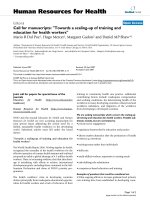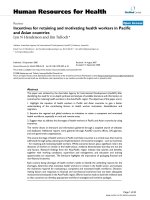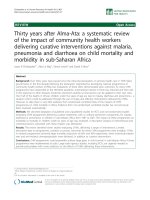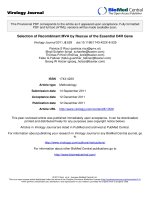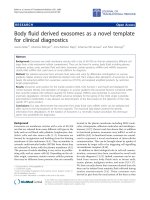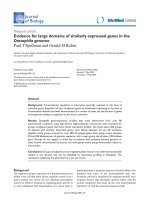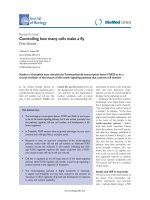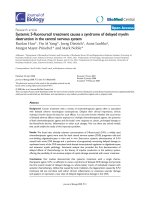Báo cáo sinh học: " Selection for litter size components: a critical review" docx
Bạn đang xem bản rút gọn của tài liệu. Xem và tải ngay bản đầy đủ của tài liệu tại đây (757.47 KB, 14 trang )
Original
article
Selection
for
litter
size
components:
a
critical
review
M
Pérez-Enciso
JP
Bidanel
2
1
Area
de
producci6
animal,
Centre
IIdL-IRTA,
25198
Lleida,
Spain;
2
Station
de
génétique
quantitative
et
appliquée,
Institut
national
de
la
recherche
agronomique,
78352
Jouy-en-Josas
cedex,
F’rance
(Received
17
January
1997;
accepted
15
July
1997)
Summary -
The
measurement
of
component
variables
such
as
the
number
of
ova
shed
(OR)
and
its
inclusion
in
a
linear
index
with
litter
size
(LS)
or
prenatal
survival
has
been
suggested
in
order
to
accelerate
genetic
progress
for
LS.
Despite
optimistic
theoretical
predictions,
however,
in
no
selection
experiment
has
the
advantage
of
including
OR
in
an
index
as
compared
to
direct
selection
for
LS
been
convincingly
demonstrated.
A
literature
survey
shows
no
clear
evidence
of
changes
in
genetic
parameters
with
selection.
By
contrast,
genetic
drift
may
suffice
to
explain
the
less
than
expected
usefulness
of
measuring
OR,
although
it
is
not
necessarily
the
sole
cause.
It
is
shown
that
an
approximate
figure
of
how
much
can
be
gained
by
measuring
OR
relative
to
direct
selection
for
LS
is
given
by
(1+(J!Ls/(J!oR)1/2
with
mass
selection,
where
y
is
the
phenotypic
variance.
Nonetheless,
the
size
of
the
experiment
needed
to
test
this
prediction
is
likely
to
be
very
large.
litter
size
/
mice
/
number
of
ova
shed
/
pig
/
index
selection
Résumé -
Sélection
des
composantes
de
la
taille
de
portée.
Une
synthèse
critique.
Plusieurs
auteurs
ont
proposé
de
mesurer
le
taux
d’ovulation
(TO)
et
de
l’inclure
avec
la
taille
de
la
portée
(TP)
dans
un
indice
de
sélection
(IX)
afin
d’accroître
l’e,!cacité
de
la
sélection
pour
TP.
Malgré
des
prédictions
théoriques
optimistes,
aucune
expérience
de
sélection n’a
pu
démontrer
de
façon
convaincante
l’avantage
d’une
sélection
sur
l’indice
IX
par
rapport
à
une
sélection
directe
sur
TP.
Une
revue
des
expériences
de
sélection
disponibles
dans
la
littérature
montre
que
la
réponse
plus faible
qu’attendue
à
une
sélection
sur
IX
ne
peut
être
expliquée
par
un
changement
des
paramètres
sous
l’effet
de
la
sélection,
mais
pourrait
l’être
par
les
effets
de
la
dérive
génétique.
De
façon
générale,
la
formule
(1
+
U2
YLS
IU2
YOR
)
1/2
@
où
U2
est
la
variance
phénotypique,
donne
une
estimation
réaliste
de
l’avantage
relatif
de
la
sélection
sur
IX
par
rapport
à
la
sélection
directe
sur
TP.
Malheureusement,
des
expériences
sur
un
grand
nombre
d’animaux
seraient
nécessaires
pour
vérifier
cette
prédiction.
index
de
sélection
/
porc
/
souris
/
taille
de
portée
/
taux
d’ovulation
*
Correspondence
and
reprints
INTRODUCTION
Reproductive
efficiency
is
one
of
the
most
important
aspects
in
a
successful
animal
breeding
scheme.
Litter
size
(LS)
is
the
trait
responsible
for
most
of
the
variation
in
overall
reproductive
performance
in
polytocous
species
and,
consequently,
LS
is
given
a
positive
economic
weight
in
all
maternal
lines
of
pigs,
sheep
and
rabbits.
Its
importance
has
even
increased
recently
in
species
such
as
pigs
owing
to
the
decreasing
economic
weight
of
backfat
thickness
and,
to
a
lesser
extent,
of
food
conversion
ratio
in
the
selection
goal.
Heritability
of
LS
(hL
S)
tends
to
be
low,
around
0.10
in
pigs
(Haley
et
al,
1988),
in
rabbits
(Blasco
et
al,
1993a;
Rochambeau
et
al,
1994)
and
in
sheep
(Bradford,
1985).
Therefore,
several
authors
have
sought
methods
aimed
at
improving
genetic
gain
in
LS
using
indirect
criteria
such
as
hormone
levels
or
number
of
ova
shed
(OR)
(Johnson
et
al,
1984;
Bodin,
1993).
Hormone
levels
have
the
advantage
that
they
can
be
measured
in
both
sexes
but
their
relationship
with
LS
often
seems
conflicting
(Bodin,
1993).
In
contrast,
the
number
of
ova
shed
always
sets
an
upper
limit
to
LS
(provided
that
identical
twins
do
not
exist
or
are
very
rare)
and
is
more
highly
heritable
than
LS;
h’OR
usually
ranges
from
0.2
to
0.4
(Blasco
et
al,
1993b).
Theoretical
results
concerning
the
value
of
measuring
OR
have
been
very
encouraging
(Johnson
et
al,
1984).
Several
experiments
have
nonetheless
questioned
these
expectations
and
led
to
apparent
contradictions.
Selection
on
an
index
combining
OR
and
prenatal
survival
(PS)
has
not
been
shown
to
be
significantly
better
than
direct
selection
on
LS
(Kirby
and
Nielsen,
1993).
Direct
selection
for
OR
resulted
in
little
or
no
increase
in
LS,
whereas
most
of
the
increase
in
prolificacy
can
be
explained
by
an
OR
augmentation
when
direct
selection
for
LS
has
been
practised.
The
objective
of
this
paper
is
to
review
the
main
selection
experiments
on
litter
size
components
in
an
attempt
to
explain
the
apparent
contradictions
between
theoretical
expectations
and
selection
results.
Discussion
of
experimental
results
will
be
within
the
theoretical
framework
to
be
presented.
Finally,
the
possible
benefits
from
measuring
OR
are
briefly
discussed.
MATERIAL
AND
METHODS
Theory
Prenatal
survival
is
by
definition
the
proportion
of
ova
shed
giving
birth
to
young,
ie,
PS
=
LS/OR.
Alternatively,
LS
=
OR -
PS.
Thus
genetic
parameters
for
OR
and
PS
determine
those
of
LS.
The
additive
variance
in
LS
()2g , LS
genetic
covariance
between
OR
and
LS
(() 90
R,
LS
)
and
PS
and
LS
(a 9P
S,LS )
are
given,
approximately,
by
(P6rez-Enciso
et
al,
1994),
where !Li
is
the
phenotypic
mean
of
trait
i and
g refers
to
genetic
values
on
the
observed
scale.
Equations
[1]
to
[3]
provide
a
means
of
estimating
realized
genetic
parameters
from
selection
experiments.
For
mass
selection
on
LS,
the
linear
regression
coeffi-
cient
of
LS
and
its
components
on
cumulated
selection
differentials
(6t cs
DLs
)
can
be
expressed
as
where
a YLS 2
is
the
phenotypic
variance
of
litter
size,
and
Og
i
is
the
genetic
change
in
trait
i.
When
selection
is
on an
index
of
the
type
bl
yoR
+
b2
Yp
s:
i
where
u y 2!.
is
the
variance
of
the
index.
Selection
for
OR
is
a
particular
case
when
b2
=
0.
Realized
values
for
69oR
,
a2p
s
and
(J
90R
,
PS
can
be
obtained
from
equations
[4]
and
[5].
When
solutions
were
out
of
the
parameter
space,
values
minimizing
the
mean
squared
differences
between
left-hand
sides
and
right-hand
sides
in
equations
[4]
and
[5]
were
used.
Statistics
for
means
and
phenotypic
variances
were
those
in
the
base
population.
Equations
[1], [2],
and
[3]
can
also
be
used
to
predict,
approximately,
selection
responses.
From
standard
results
for
index
selection
theory
(Falconer
and
Mackay,
1996)
the
expected
response
in
LS
using
an
index,
IX,
combining
OR
and
LS
relative
to
direct
selection
on
LS
is,
approximately,
with
mass
selection
and
one
record
per
individual,
where
pg
is
the
genetic
correlation
between traits.
Literature
reviews
Two
literature
surveys
were
carried
out.
The
first
one
concerned
reported
estimates
of
the
pertinent
genetic
parameters
in
pigs,
mice
and
rabbits,
in
order
to
validate
predictions
from
equations
!1!,
[2]
and
!3!.
In
the
second
literature
survey,
selection
experiments
for
LS
and
its
components
were
reviewed.
From
the
experiments
where
selection
was
for
LS,
we
analysed
only
those
in
which
OR
had
been
measured
at
least
in
some
generation.
Selection
differentials
were
converted
to
mass
selection
differentials
averaged
over
sexes.
Whenever
the
authors
did
not
provide
explicit
values
for
selection
differentials
or
phenotypic
means
these
were
calculated,
if
possible,
from
the
figures.
RESULTS
Results
from
the
first
literature
survey
are
given
in
table
I,
which
shows
the
esti-
mated
and
predicted
figures
for
hL
S,
P90R
,
Ls
and
Pg
PS
,
LS
’
Even
if
equations
[1]-[3]
are
only
first
order
approximations,
agreement
between
reported
and
predicted
ge-
netic
parameters
was
very
reasonable
in
most
instances.
The
only
exception
was
the
Neal
et
al
(1989)
experiment,
which
gave
a
negative
estimate
of
Pg.
,,,
Ll
.
However,
the
realized
genetic
correlation
was
positive
(see
below,
table
III).
Interestingly,
predictions
from
equations
!1!,
[2]
and
[3]
were
closer
for
REML
estimates
than
for
estimates
by
other
methods.
If
we
consider
that
REML
estimates
are
more
accurate
than
Anova-type
estimates,
this
suggests
in
turn
that
the
above
equations
might
be
used
to
test
how
’coherent’
the
estimates
of
genetic
parameters
are
from
a
trait
that
can
be
expressed
as
the
product
or
ratio
of
two
other
traits.
Concerning
the
second
literature
review,
a
total
of
12
relevant
experiments
for
LS
or
its
components
were
found
(table
II).
Only
three
experiments
compared
simultaneously
different
selection
criteria
(references
5,
9
and
10
in
table
II).
These
experiments
provide
most
of
the
information
regarding
the
usefulness
of
alternative
selection
methods.
The
experiment
by
Kirby
and
Nielsen
(1993)
is
unique
in
its
duration,
21
generations,
and
in
its
reliability,
as
it
was
repeated
three
times.
Bidanel
et
al
(1995)
compared
selection
on
OR
at
puberty
with
what
they
called
corrected
PS,
actually
an
index
selection
comprising
PS
and
OR.
Most
experiments
listed
in
table
II
were
aimed
at
increasing
reproductive
efficiency,
and
evidence
concerning
asymmetrical
response
can
be
conveyed
only
from
Falconer’s
experiments
in
mice
(Falconer,
1960;
Land
and
Falconer,
1969)
and
more
recently
from
experiments
in
rabbits
(Santacreu
et
al,
1994;
Argente
et
al,
1997).
The
experiment
in
rabbits
was
for
LS
but
after
hysterectomy
in
order
to
improve
the
so-called
uterine
capacity,
and
thus
their
results
may
not
be
directly
comparable
with
those
for
natural
LS.
Mass
or
within
family
selection
was
used
except
in
Argente
et
al
(1997)
and
in
Noguera
et
al
(1994,
1998)
where
BLUP
evaluation
was
employed.
The
use
of
BLUP
certainly
accelerates
genetic
progress
but
makes
the
analysis
of
selection
applied
more
complicated.
Realized
genetic
parameters
were
calculated
using
equations
[4]
and
[5]
when
enough
information
was
provided
by
the
authors.
That
was
the
case
in
four
experiments
in
mice
and
pigs
(table
III).
Genetic
parameters
were
computed
in
the
first
half
and
in
the
whole
experiment
in
order
to
study
their
stability,
except
in
Casey
et
al
(1994),
where
the
whole
experiment
could
not
be
analysed
together
because
index
weights
were
changed
in
generation
6.
DISCUSSION
We
will
concentrate
on
the
following
issues.
a)
What
is
the
nature
of
correlated
changes
in
OR
when
selection
has
been
practiced
on
LS ?
b)
How
stable
are
genetic
parameters
with
selection ?
c)
What
is
the
influence
of
genetic
drift
on
experimental
results?
d)
How
close
is
LS
to
the
optimum
selection
index?
Correlated
changes
in
the
number
of
ova
shed
Correlated
and
direct
responses
in
OR
are
at
first
sight
surprising.
As
table
II
shows,
when
selection
has
been
carried
out
for
LS,
its
increase
has
been
due
to
an
OR
change
(ALS /AOR *
1)
in
all
species
reviewed.
Quite
to
the
contrary,
when
selection
was
on
OR,
correlated
response
in
LS
was
close
to
nil
(ALS /AOR *
0.1).
Bradford
et
al
(1980)
described
these
observations
as
a
&dquo;striking
example
of
asymmetrical
correlated
response&dquo; .
The
fact
that
the
ratio
OLS/
D
OR
is
close
to
one
for
direct
selection
on
LS
implies
a2 9LS
^
0&dquo; gO
R,
LS
’
Note
that
this
condition
cannot
be
fulfilled
unless
there
exists
genetic
variation
for
PS
because
otherwise
it
would
imply
that
wP
S6
9oR ^
U
pg
O&dquo;!OR’
,
ie,
J
.!p
s
=
1,
which
is
never
the
case.
From
the
condition
o!9LS !
690R
,
LS
) it
follows
that
’
For
typical
figures,
eg,
f
1.0
R
=
15,
f1.p
s
=
0.70-0.75,
z =
15-25,
equations
[7]
and
[9]
predict
strong
and
negative
genetic
correlations
between
OR
and
PS,
pg
.R
,,,
<
-0.7.
The
number
of
ova
shed
increased
when
selection
was
on
’corrected’
PS
(PS
+
0.018
OR)
in
the
Bidanel
et
al
(1995)
experiment.
Here,
the
condition
for
OR
to
increase
is
Cov(gps
+
bgOR
,
90R
)
>
0,
which
implies,
b >
-P
90R
,ps/z,
For
extreme
negative
values
of,
say
P90R
,p
s
less
than
-0.8,
b
has
to
be
larger
than
0.03.
Results
in
Bidanel
et
al
(1995)
hence
implied
that
p
9oR
,
PS
had
a
moderately
negative
value
in
their
population.
’
The
largest
ratio,
!LS/!OR
=
1.37,
was
attained
when
selecting
on
what
Bradford
(1969)
called
’adjusted
PS’,
actually
PS .
LS.
The
breeding
value
for
this
trait
can
be
approximated
by
f1.!s gOR
+
2
f1.0
R
f
1.p
s
gps,
and
the
expected
ratio
ALS/AOR
in
this
case
is,
approximately
Substituting
equations
[1]
and
[3]
into
[9]
and
solving
for
P90
R,
PS’
it
follows
that
By
substituting
Bradford’s
means
above
and
for
a
range
of
values
of
z
a
strong
negative
correlation
is
found
again,
although
out
of
the
parameter
space,
probably
because
of
the
successive
approximations
involved
in
!9!.
Thus,
apparent
contradicting
results
in
correlated
changes
between
OR
and
LS
implies
that
there
exists
a
negatively
correlated
genetic
variation
for
OR
and
PS.
Stability
of
genetic
parameters
A
common
explanation
for
the
less
than
expected
response
to
selection
is
that
ge-
netic
parameters
have
changed
during
the
selection
process
(eg,
Caballero,
1989).
In
this
respect
the
experiment
by
Nielsen
and
co-workers
(Gion
et
al,
1990;
Kirby
and
Nielsen,
1993;
Clutter
et
al,
1994)
deserves
special
attention
as
it
is
the
only
work,
to
our
knowledge,
where
direct
selection
for
LS
has
been
compared
simultaneously
with
a
linear
index
based
on
OR
and
PS.
The
expected
advantage
of
the
index
based
on
genetic
parameters
in
the
base
population
(Clutter
et
al,
1990)
was
Rix/R
LS
= 1.25,
which
was
close
to
the
observed
ratio
at
the
13th
generation,
R
IX/
R
LS
= 1.33,
but
not
in
the
21st
generation
R
IX/
R
LS
=
1.00.
The
authors
argued
that
lack of
advantage
of
an
index
over
direct
selection
in
the
long
term
was
due
to
not
updating
index
weights.
In
principle,
the
need
for
updating
genetic
parameters
is
more
important
in
this
case,
as
a
linear
index
is
only
an
approximation
and
optimum
weights
depend
not
only
on
variances
but
also
on
means
(Johnson
et
al,
1984).
An
assessment
of
the
rate
of
change
in
genetic
parameters
can
be
deduced
from
realized
genetic
correlations,
which
can
be
obtained
via
equations
[4]
and
[5]
(table
III,
reference
1).
Two
aspects
are
worth
noting.
First,
there
is
no
evidence
that
genetic
parameters
changed
dramatically
in
later
generations
of
selection,
which
makes
it
unlikely
that
not
updating
the
index
weights
had
changed
the
results
very
much.
P6rez-Enciso
et
al
(1994)
showed
that
the
optimum
index
weight
for
PS
increased
with
selection
but
indices
were
rather
robust
and
not
significantly
better
than
direct
selection
on
LS.
Second,
parameters
were
similar
in
both
lines
and
to
those
estimated
in
the
base
population
(table
I),
although
hL
S
was
clearly
overestimated
with
respect
to
the
realized
value.
Results
from
the
divergent
selection
for
OR
(Land
and
Falconer,
1969)
are
particularly
interesting.
In
analysing
the
whole
experiment,
a
clear
asymmetric
response
between
upward
and
downward
lines
was
obtained.
A
correlated
response
in
the
expected
direction
for
LS
appeared
only
in
the
downward
line
(
P90R
,
LS
>
0!8),
whereas
LS
even
decreased
in
the
upward
line.
Falconer
(1960)
observed
an
increase
in
OR
in
two
lines
selected
for
high
and
low
LS,
which
again
indicates
an
asymmetry
in
the
correlations
between
OR
and
LS.
Unfortunately,
OR
was
monitored
in
two
generations
only,
so
that
P90R,LS
can
not
be
accurately
determined.
Results
of
selection
for
OR
in
pigs
are
very
similar
to
those
in
mice.
Interestingly,
simulation
results
have
shown
that
measuring
OR
should
be
more
useful
to
decrease
rather
than
to
increase
LS
(P6rez-Enciso
et
al,
1996).
These
results
are
due
to
a
non-linear
relationship
between
OR
and
LS.
Table
III
shows
that,
in
general,
heritabilities
are
more
stable
than
genetic
correlations.
All
in
all,
it
seems
that
genetic
parameters
did
not
change
dramatically
with
selection.
Given
the
small
number
of
experiments
and
the
sampling
errors
in
estimating
realized
genetic
correlations,
though,
this
conclusion
should
be
taken
with
caution
and
differential
changes
according
to
selection
criteria
or
in
divergent
lines
cannot
be
ruled
out.
Genetic
drift
Assuming
that
the
response
is
linear,
the
difference
between
two
lines
in
generation
t is
Dt
=
t(R
I
x -
R
LS),
where
R
is
the
response
per
generation
with
each
criterion,
an
index
or
direct
selection.
The
minimum
number
of
generations
needed
to
detect
significant
differences
between
alternative
criteria
can
then
be
calculated
applying
Hill’s
(1980)
formula,
where
Ne
is
the
effective
size,
M
is
the
number
of
measured
records
per
generation
and
a)
is
the
phenotypic
variance.
Again,
the
experiment
by
Nielsen
and
co-
workers
is
particularly
illustrative.
Assuming
estimated
genetic
parameters
in
the
base
population,
average
realized
selection
intensity,
Ne
=
37
(calculated
from
the
average
increase
in
inbreeding
over
the
three
replicates)
and
M
=
100,
it
is
found
that
a
minimum
of
24
generations
of selection
should
have
been
needed
in
order
to
detect
significant
differences
(a
=
0.05).
Thus
the
experiment
may
not
have
been
powerful
enough
to
detect
differences
between
criteria
and
genetic
drift
is
a
plausible
explanation
for
the
results.
An
illustration
of
the
impact
of
drift
on
experimental
power
is
provided
by
figure
1.
This
figure
shows
the
minimum
number
of
generations
needed
to
detect
differences
between
index
and
direct
selection
for
LS
under
individual
mass
selection
and
different
selection
intensities
and
population
sizes.
The
population
statistics
used
are
given
in
table
IV
and
are
representative
of
French
Large
White
pig
populations
(eg,
Bidanel
et
al,
1996;
Blasco
et
al,
1996),
but
the
numbers
in
figure
1
will
be
roughly
similar
in
other
populations.
It
is
apparent
that,
from
all
the
reviewed
experiments
in
table
II,
only
Falconer’s
(1960)
results
would
have
been
informative
for
the
sake
of
comparing
different
criteria.
How
close
is
LS
to
the
‘optimum’
index ?
Litter
size
can
be
thought
of
as
a
natural
index
combining
OR
and
PS
(Johnson
et
al,
1984)
and
it
will
be
the
optimum
index
only
if
Pgl!1,Ll
=
0,
ie,
when
measuring
OR
does
not
convey
any
information
about
LS.
Otherwise
a
linear
index
can
be
derived
such
that,
in
principle,
response
in
LS
is
larger
than
with
direct
selection
at
least
in
the
first
stages
of
selection.
The
extent
to
which
LS
is
close
to
the
’optimum’
index
can
be
assessed
by
means
of
retrospective
indices.
Retrospective
weights
are
defined
as
wR
=
G-
IA9,
where
G
is
the
genetic
covariance
matrix
between
OR
and
PS
and
Ag
is
the
vector
containing
changes
in
these
two
traits
(van
Vleck,
1993),
ie,
Using
realized
genetic
parameters,
relative
weights
1:
wps/
W
OR
were
1:5.3
and
1:10.8
for
IX
and
LS
lines
in
Kirby
and
Nielsen’s
(1993)
experiment
in
mice.
In
pigs,
selection
on
an
index
(Casey
et
al,
1994)
resulted
in
a
relative
weight
w
PS/
wo
R
=
8.1
but
had
selection
been
on
LS,
w
PS/
wo
R
would
have
been
19.5.
As
expected,
optimum
index
selection
is
associated
with
a
larger
increase
in
OR
than
direct
selection,
but
the
differences
are
not
dramatic.
It
is
generally
accepted
that
doubling
the
economic
value
for
one
of
the
traits
changes
selection
efficiency
by
only
a
few
percent
(Weller,
1994).
It
can
be
shown
that
when
selection
is
on
LS,
(Smith,
1967;
P6rez-Enciso
et
al,
1994),
that
is,
relative
changes
in
its
components
are
independent
of
genetic
parameters.
Note
that
these
weights
are
not
constant,
as
OR
and
PS
means
change
with
selection,
and
thus
LS
behaves
as
a
self-adjusted
non-linear
index.
If
a
linear
index
combining
OR
and
PS
is
used,
the
equivalent
expression
is:
Similarity
between
equations
[11]
and
[12]
provides
a
measurement
of
how
close
LS
is
to
an
optimum
linear
index.
GENERAL
DISCUSSION
AND
CONCLUSION
In
practice,
the
animal
breeder
is
mainly
interested
in
how
much
can
be
gained
by
measuring
OR. The
maximum
advantage
of
including
OR
occurs
when
h p 2
S
=
0,
because
then
OR
and
LS
are
repeated
measurements
of
the
same
trait
but
at
different
stages
of
gestation,
ie,
P90R
,
LS
=
1.
In
this
particular
case
(Appendix)
where
k
=
!LOR(L -
!LpS)/!LpS
!on’
Because
k
is
positive,
hfs
is
always
smaller
than
h 2 O
R
if
hp
s 2
=
0,
the
smaller
!ips
the
larger
the
reduction.
The
upper
limit
of
the
ratio
R
IXMAX /R
LS
is
[2
+
kJl/2,
which
follows
from
equations
[6]
and
!13!.
Similarly,
the
maximum
ratio
of
indirect
response
in
LS
when
selecting
on
OR
to
direct
response,
CRoRMAX/RLS!
is,
approximately,
[1
+
k]I
/2
.
For
most
species
and
populations,
k
ranges
between
0.6
and
1.5
and
thus
the
theoretical
upper
limit
to
relative
increase
in
response
with
mass
selection
by
measuring
OR
is
about
1.5
and
2
times.
In
general
terms,
the
larger
prenatal
mortality
and
the
smaller
h p 2S,
the
larger
the
value
of
measuring
OR.
From
the
previous
analyses,
it
seems
that
these
optimistic
predictions
have
not
been
realized
owing
to
a
negative
genetic
correla-
tion
between
OR
and
PS,
whereas
the
impact
of
changes
in
the
genetic
parameters
is
probably
limited.
Under
the condition
cr2g LS !
u 90R,LS !
which
follows
from
the
fact
that
ALS/AOR
is
close
to
one
for
direct
selection
on
LS,
equation
[6]
simplifies
to
for
typical
figures
in
polytocous
species.
Nonetheless,
figure
1
suggests
that
very
large
experiments
are
needed
in
order
to
test
the
advantage
of
index
selection
over
direct
selection.
Genetic
drift
may
suffice,
although
it
is
not
necessarily
the
sole
cause,
to
explain
why
experiments
to
validate
the
theoretical
advantage
of
measuring
OR
have
failed.
Note
in
addition
that
figure
1
is
rather
a
lower
limit
for
experimental
size
because
a
linear
response
is
assumed
and
that
genetic
parameters
are
assumed
known
without
error.
Sheridan
(1988),
observed
that
realized
heritabilities
were
less
than
expected
in
57%
of
198
experiments
reviewed
and
greater
than
expected
in
38%
of
the
cases,
which
suggests
that
genetic
drift
is
a
common
explanation
for
lack
of
agreement
between
theory
and
experimental
results.
Bradford
remarked
in
1980
that
’selection
for
litter
size
is
remarkably
effective,
and
to
date
no
better
selection
criterion
for
improving
mean
number
of
young
born
per
litter
has
been
identified’.
It
seems
that
this
statement
has
not
been
convincingly
refuted
because
the
size
of
the
experiment
needed
is
likely
to
be
very
large.
ACKNOWLEDGMENTS
We
wish
to
thank
G
Bolet
and
MK
Nielsen
for
their
useful
comments,
and
JL
Noguera
for
sharing
unpublished
results.
This
work
was
supported
by
INIA
grant
No
9084
(Spain)
and
by
a
French-Spanish
’Acci6n
Integrada’
No
70B.
REFERENCES
Argente
MJ,
Santacreu
MA,
Climent
A,
Bolet
G,
Blasco
A
(1997)
Divergent
selection
for
uterine
capacity
in
rabbits.
J
Anim
Sci
75,
2350-2354
Bidanel
JP,
Blasco
A,
Dando
P,
Gogue
J
(1995)
Results
of
four
generations
of
selection
for
ovulation
rate
or
prenatal
survival
in
French
Large
White
pigs.
Proc
46th
EAAP
Meet,
(Abstr)
1,
52
Bidanel
JP,
Gruand
J,
Legault
C
(1996)
Genetic
variability
of
age
and
weight
at
puberty,
ovulation
rate
and
embryo
survival
in
gilts
and
relations
with
production
traits.
Genet
Sel
Evol
28,
103-117
Blasco
A,
Bidanel
JP,
Bolet
G,
Haley
CS,
Santacreu
MA
(1993a)
Genetic
variability
in
prenatal
survival
of
polytocous
species:
a
review.
Livest
Prod
,5’ci
37,
1-21
Blasco
A,
Santacreu
MA,
Thompson
R,
Haley
CS
(1993b)
Estimates
of
genetic
parameters
for
ovulation
rate,
prenatal
survival
and
litter
size
in
rabbits
from
an
elliptical
experiment.
Livest
Prod
Sci
34, 163-174
Blasco
A,
Gogue
J,
Bidanel
JP
(1996)
Relationships
between
ovulation
rate,
prenatal
survival
and
litter
size
in
French
Large
White
pigs.
Anim
Sci
63,
143-148
Bodin
L
(1993)
Indirect
selection
criterion
of
female
reproductive
traits.
Proc
44th
EAAP
Meet
Bolet
G,
Brun
JM,
Hulot
F,
Poujardieu
B,
Rochambeau
H
de
(1990)
Strategies
pour
am6liorer
la
taille
de
port6e
chez
le
lapin:
R6sultats
et
perspectives.
Proc
l!Ist
EAAP
Meet
Bolet
G,
Ollivier
L,
Dando
P
(1989)
Selection
sur
la
prolificit
6
chez
le
porc.
I.
R6sultats
d’une
experience
de
selection
sur
onze
generations.
Genet
Sel
Evol 21,
93-106
Bolet
G,
Santacreu
MA,
Argente
MJ,
Climent
A,
Blasco
A
(1994)
Divergent
selection
for
uterine
efficiency
in
unilaterally
ovariectomized
rabbits.
I.
Phenotypic
and
genetic
parameters.
Proc
5th
World
Cong
Genet
Appl
Livest
Prod
19, 261-264
Bradford
GE
(1968)
Selection
for
litter
size
in
mice
in
the
presence
and
absence
of
gonadotropin
treatment.
Genetics
58,
283-295
Bradford
GE
(1969)
Genetic
control
of
ovulation
rate
and
embryo
survival
in
mice.
I.
Response
to
selection.
Genetics
61,
905-921
Bradford
GE
(1985)
Selection
for
litter
size.
In:
Genetics
of
Reproduction
in
Sheep
(RB
Land,
DW
Robinson,
eds),
Butterworths,
London,
3-18
Bradford
GE,
Barkley
MS,
Spearow
JL
(1980)
Physiological
effects
of
selection
for
aspects
of
efficiency
of
reproduction.
In:
Selection
Experiments
in
Laboratory
and
Domestic
Animals
(A
Robertson,
ed),
CAB
International,
Slough,
161-175
Brun
JM,
Bolet
G,
Ouhayoun
J
(1992)
The
effects
of
crossbreeding
and
selection
on
productive
and
reproductive
traits
in
a
triallele
experiment
between
three
strains
of
rabbits.
J
Appl
Rabbit
Res
15,
181-189
Caballero
A
(1989)
Efficiency
in
prediction
of
response
in
selection
index
experiments.
J
Anim
Breed
Genet
106,
187-194
Casey
D,
Rathje
TA,
Johnson
RK
(1994)
Response
to
ten
generations
of
index
selection
for
components
of
litter
size in
swine.
Proc
5th
World
Cong
Genet
Appl
Livest
Prod
17, 315-318
Clutter
AC,
Nielsen
MK,
Johnson
RK
(1990)
Alternative
methods
of
selection
for
litter
size
in
mice.
I.
Characterization
of
base
population
and
development
of
methods.
J
Anim
Sci
68,
3536-3542
Clutter
AC,
Kirby
YLK,
Nielsen
MK
(1994)
Uterine
capacity
and
ovulation
rate
in
mice
selected
21
generations
on
alternative
criteria
to
increase
litter
size.
J
Anim
Sci
72,
577-583
Cunningham
PJ,
England
ME,
Young
LD,
Zimmerman
DR
(1979)
Selection
for
ovulation
rate
in
swine:
correlated
response
in
litter
size
and
weight.
J
Anim
Sci
48,
509-516
Falconer
DS
(1960)
The
genetics
of
litter
size
in
mice.
J
Cell
Comp
Phys
56
(Suppl
1),
153-167
Falconer
DS,
Mackay
TFC
(1996)
Introduction
to
Quantitative
Genetics.
Longman,
London,
4th
ed
Gion
JM,
Clutter
AC,
Nielsen
MK,
(1990)
Alternative
methods
of
selection
for
litter
size
in
mice.
II.
Response
to
thirteen
generations
of
selection.
J
Anim
Sci
68,
3543-3556
Haley
CS,
Avalos
E,
Smith
C
(1988)
Selection
for
litter
size
in
the
pig.
Anim
Breed
Abst
56,
317-332
Haley
CS,
Lee
GJ
(1992)
Genetic
factors
contributing
to
variation
in
litter
size
in
British
Large
White
gilts.
Livest
Prod
Sci
30,
99-113
Hill
WG
(1980)
Design
of
quantitative
genetic
selection
experiments.
In:
Selection
Ex-
periments
in
Laboratory
and
Domestic
Animals
(A
Robertson,
ed),
Commonwealth
Agricultural
Bureau,
Slough
Johnson
RK,
Zimmerman
DR,
Kittok
RJ
(1984)
Selection
for
components
of
reproduction
in
swine.
Livest
Prod
,5’ci
11, 541-558
Kirby
YK,
Nielsen
MK
(1993)
Alternative
methods
of
selection
for
litter
size
in
mice.
III.
Response
to
21
generations
of
selection.
J
Anim
Sci
71, 571-578
Land
RB,
Falconer
DS
(1969)
Genetic
studies
of
ovulation
rate
in
the
mouse.
Genet
Res
13,
25-46
Neal
SM,
Johnson
RK
(1986)
Selection
for
components
of
litter
size
in
swine:
genetic
parameters
and
expected
response.
Proc
3rd
World
Cong
Genet
Appl
Livest
Prod
11,
228-233
Neal
SM,
Johnson
RK,
Kittok
RJ
(1989)
Index
selection
for
components
of
litter
size
in
swine:
response
to
five
generations
of
selection.
J
Anim
Sci
67,
1933-1945
Noguera
JL,
P6rez-Enciso
M,
Alfonso
L,
Babot
D,
Estany
J
(1994)
A
selection
experiment
for
increasing
litter
size
of
Landrace
pigs
in
Spain.
Proc
5th
World
Cong
Genet
Appl
Livest
Prod
17,
343-346
Noguera
JL,
Alfonso
L,
Babot
D,
P6rez-Enciso
M,
Estany
J
(1998)
Results
of
an
experiment
for
the
selection
of
litter
size in
pigs
by
means
of
a
hyperprolific
breeding
scheme.
Proc
6th
World
Cong
Genet
Appl
Livest
Prod
(in
press)
P6rez-Enciso
M,
Foulley
JL,
Bodin
L,
Poivey
JP
(1994)
Genetic
implications
of
a
bivariate
threshold
model
for
litter
size
components.
J
Anim
Sci
72,
2775-2786
P6rez-Enciso
M,
Bidanel
JP,
Baquedano
MI,
Noguera
JL
(1996)
A
comparison
of
alterna-
tive
genetic
models
for
litter
size
in
pigs.
Anim
Sci
63,
255-264
Rochambeau
H
de,
Bolet
G,
Tudela
F
(1994)
Long
term
selection -
comparison
of
two
rabbit
strains.
Proc
5th
World
Cong
Genet
Appl
Livest
Prod
19,
257-260
Santacreu
MA,
Argente
MJ,
Climent
A,
Blasco
A,
Bolet
G
(1994)
Divergent
selection
for
uterine
efficiency
in
unilaterally
ovariectomized
rabbits.
II.
Response
to
selection.
Proc
5th
World
Cong
Genet
Appl
Livest
Prod
19,
265-268
Sheridan
AK
(1988)
Agreement
between
estimated
and
realised
genetic
parameters.
Anim
Breed
Abst
56,
877-889
Smith
C
(1967)
A
note
on
the
improvement
of
a
trait
by
selecting
on
its
components.
Anim
Sci
9,
127-130
van
Vleck
LD
(1993)
Selection
Index
and
Introduction
to
Mixed
Model
Methods.
CRC
Press,
Boca
Raton
Weller
J
(1994)
Economic
Aspects
of
Animal
Breeding.
Chapman
and
Hall,
London
Zimmerman
DR,
Cunningham
PJ
(1975)
Selection
for
ovulation
rate
in
swine:
population
procedures
and
ovulation
response.
J
Anim
Sci
40,
61-69
APPENDIX:
PREDICTION
OF
GENETIC
VARIATION
IN
LITTER
SIZE
WHEN
HERITABILITY
OF
PRENATAL
SURVIVAL
IS
NIL
The
phenotypic
variance
of
LS
in
terms
of
those
of
OR
and
PS
can
be
obtained
from:
where
Var(LS!OR
=
x)
and
E(LS!OR
=
x)
are
the
phenotypic
variance
and
mean
litter
size
for
OR
=
x,
respectively.
In
the
particular
case
of
no
genetic
variation
in
PS,
Var(LSIOR
=
x)
=
x
!-lps(1 -
!
-lp
s)
and
E(LSIOR
=
x)
=
x
!ips,
because
vps
is
constant
for
all
OR.
Thus

